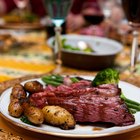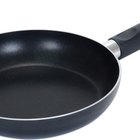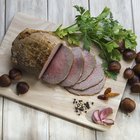bhofack2/iStock/GettyImages
Beef roasts range from nondescript pieces of chuck for pot roast, to large and tender premium cuts for special occasions. The king of them all is the standing rib roast or prime rib, a juicy and richly flavorful cut. It is usually roasted in the oven, but a grill with a rotisserie attachment can make your standing rib roast even more memorable. Rotisseries cook the roast evenly from all sides, giving slice after slice of perfectly cooked beef.
Mount the rotisserie unit to your grill. Prepare and light the coals, if you have a charcoal grill, or light the gas and preheat your gas grill to a moderate temperature of 275 to 300 degrees Fahrenheit.
Dry the surface of your roast by patting it with clean paper towels, rubbing the ends of the bones to remove any fragments left by the butcher's saw. Season the roast liberally with salt and pepper, garlic, rosemary or any other flavorings you like.
Lift the roast and turn it a few times to get a sense of its center of balance. Push the long central spit of the rotisserie through the roast from end to end, as close to that center as possible. Slide the rotisserie's forks into place to grip the roast tightly. Rotate the shaft to check its balance. If it's noticeably off-center, remove and re-insert the spit so it's better balanced.
Open the lid of your grill and snap the spit into the rotisserie assembly. Close the lid and start the rotisserie's motor. Calculate your cooking time at 15 to 20 minutes per pound. A 6- to 7-pound standing rib will usually take two to two and a half hours.
Open the grill's lid after two hours and test the roast's internal temperature with an instant-read thermometer. When the temperature reaches 115 F in the middle of your roast, increase the gas to high or open the draft on your charcoal grill. Cook at high temperature for another 10 to 15 minutes, to finish browning the roast's exterior.
Remove the roast from your rotisserie when its internal temperature reaches 120 F to 125 F for rare beef or 130 to 135 for medium-rare. The roast will continue to cook for the next several minutes, gaining another eight to 10 degrees.
Related Articles

How to Cook Prime Rib Using an Oven ...

How to Cook a Deer Neck Roast in a Slow ...
How do I Cook a Prime Rib on an Open ...

How to Grill a Ribeye on a Weber Q

How to Cook a Roast Beef on a ...
How to Cook a Seven Bone Pot Roast in ...

How to Marinate a Top Round Roast

How to Cook Beef Top Round Pot Roast

How to Bake a Pork Loin Center Half
How to Cook a Spencer Roast
How to Smoke Venison Neck Roast

How to Roast a Pork Blade Cut

How to Cook a Rotisserie Sirloin Tip ...

How to Cook a 15-Pound Rib Roast

How to Cook an 8- to 10-Pound Beef ...

How to Cook Tender Rolled Flank Steaks ...

How to Cook a Tender Eye Roast
How to Cook a Lamb Square Cut Shoulder

How to Broil Filet Mignon Wrapped in ...
How to Cook Prime Rib on an Electric ...
References
Tips
- Some cooks rub their roasts with a spice rub or seasoning paste the night before cooking it. Pastes and spice rubs can develop harsh flavors if they burn, so exercise extra care when you're browning the roast at the end of your cooking time.
- Many recipes and grilling guides suggest browning the roast at high heat at the beginning of your cooking time. That also works, though browning at the end gives better control over your final result.
- Some indoor ranges and countertop convection ovens have a rotisserie attachment as well. A rib roast can be cooked in your home oven using the same technique, although it won't have the distinctive flavor of the grill. Few countertop ovens are large enough to accommodate a standing rib roast, and their motors aren't usually powerful enough for a roast that size.
Warnings
- Use heatproof gloves when snapping the rotisserie into place on the grill and when removing it. Handling the spit carelessly can result in serious burns.
Writer Bio
Fred Decker is a trained chef and prolific freelance writer. In previous careers, he sold insurance and mutual funds, and was a longtime retailer. He was educated at Memorial University of Newfoundland and the Northern Alberta Institute of Technology. His articles have appeared on numerous home and garden sites including GoneOutdoors, TheNest and eHow.